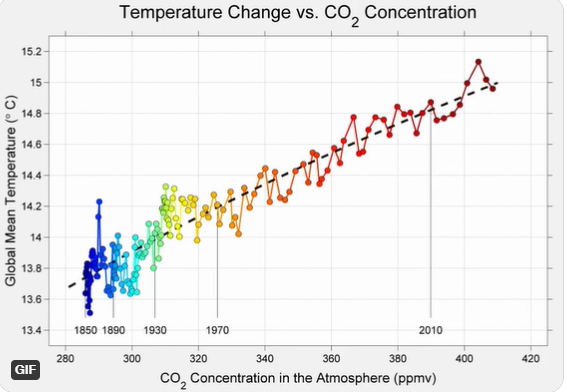By Andy May
I had a very interesting online discussion about CO2 and temperature with Tinus Pulles, a retired Dutch environmental scientist. To read the whole discussion, go to the comments at the end of this post. He presented me with a graphic from Dr. Robert Rohde from twitter that you can find here. It is also plotted below, as Figure 1.

Figure 1. Robert Rohde’s plot of CO2 versus global temperature and a logarithmic fit.
Rohde doesn’t tell us what temperature record he is using, nor does he specify what the base of the logarithm is. Figure 2 is a plot of the HadCRUT5 temperature anomaly versus the logarithm, base 2, of the CO2 concentration. It is well known that temperature increases as the CO2 concentration doubles, so the logarithm to the base 2 is appropriate. When the log, base 2, goes up by one, it means the CO2 concentration has doubled.

Figure 2. The orange line is the log2CO2, use the right-hand scale. The multicolored line is the HadCRUT5 land + ocean global surface temperature record, it uses the left scale. The different colors identify the periods shown in the legend
In Figure 2 we can see that the relationship between CO2 and temperature is close to what we expect from 1980 to 2000, from 2000 to today, warming is a bit faster than we would predicing.t from the change in CO2. From 1850 to 1910 and 1944 to 1976 temperatures fall, but CO2 increases. From 1910 to 1944 temperatures rise much faster than can be explained by changes in the CO2 concentration. These anomalies suggest other forces are at work that are as strong as CO2-based warm
Figure 3 is just like Figure 2 but the older non-infilled HadCRUT4 land plus ocean temperature record is used.

Figure 3. HadCRUT4 and NASA CO2. Unlike Figure 2, this record shows the pause in warming from 2000 to 2014.
The HadCRUT4 record is not infilled, just actual data in sufficiently populated grid cells, and it shows the well-known pause in warming from 2000 to 2014, shown in green. Compare the green region in Figure 3 to the same region in Figure 2. They are quite different, even though they use essentially the same data.
So, with that background let’s look at a plot like Robert Rohde’s. Our version is shown in Figure 4. The various periods being discussed are coded in the same colors as in Figures 1 and 2.

Figure 4. Our version of Robert Rohde’s plot. We use the HadCRUT5 temperatures and NASA CO2. Note NASA’s CO2 record reverses from 1941-1950. This makes the plot look funny.
The R2 (coefficient of correlation) between Log2CO2 and temperature is 0.87, so the correlation is not significant at the 90% or 95% level, but it is respectable. Here we need to be careful, because correlation does not imply causation, as the old saying goes. Further, if CO2 is the “control knob” for global warming (Lacis, Schmidt, Rind, & Ruedy, 2010), then how do we explain the periods when the Earth cooled? The IPCC AR6 report also claims that CO2 is the control knob of global warming on page 1-41, where they write this:
“As a result, non-condensing greenhouse gases with much longer residence times serve as ‘control knobs’, regulating planetary temperature, with water vapour concentrations as a feedback effect (Lacis et al., 2010, 2013). The most important of these non-condensing gases is carbon dioxide (a positive driver)”
AR6, p. 1-41
Jamal Munshi compares the correlation between temperature and CO2 to the correlation between CO2 and homicides in England and shows the homicides correlate better (Munshi, 2018). Spurious correlations occur all the time and we need to be wary of them. They are particularly common in time series data, such as climate records. Munshi concludes that there is “insufficient statistical rigor in [climate] research.”
Figure 5 shows the same plot, but using the older HadCRUT4 record, which uses almost the same data as HadCRUT5, but empty cells in the grid are not infilled.

Figure 5. The same plot of Log2CO2 versus temperature but using the HadCRUT4 record.
In Figure 5 the coefficient of correlation is worse, about 0.84. This record also has the same problem with reversing temperature trends as CO2 increases. HadCRUT4 shows the pause better than HadCRUT5, but oddly, the trend is a better match to the CO2 concentration.
Conclusion
I’m not impressed with Rohde’s display. The coefficient of correlation is decent, but it does not show that warming is controlled by changes in CO2, the temperature reversals are not explained. The reversals strongly suggest that natural forces are playing a significant role in the warming and can reverse the influence of CO2. The plots show that, at most, CO2 explains about 50% of the warming, something else, like solar changes, must be causing the reversals. If they can reverse the CO2-based warming and overwhelm the influence of CO2 they are just as strong.
Works Cited
Lacis, A., Schmidt, G., Rind, D., & Ruedy, R. (2010, October 15). Atmospheric CO2: Principal Control Knob Governing Earth’s Temperature. Science, 356-359. Retrieved from https://science.sciencemag.org/content/330/6002/356.abstract
Munshi, Jamal (2018, May). The Charney Sensitivity of Homicides to Atmospheric CO2: A Parody. SSRN
Author

Biography
Andy May is a writer, blogger, and author living in The Woodlands, Texas; and enjoys golf and traveling in his spare time. He is the author of two books on climate change issues and one on Kansas history. Andy is the author or co-author of seven peer-reviewed papers on various geological, engineering and petrophysical topics. He retired from a 42-year career in petrophysics in 2016. You can find many of his posts on the popular climate change blog Wattsupwiththat.com, where he is an editor. His personal blog is andymaypetrophysicist.com.
